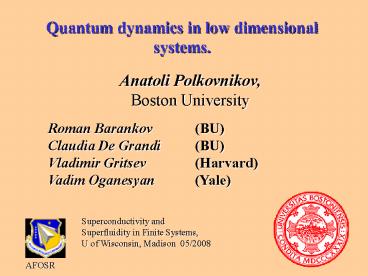Quantum dynamics in low dimensional systems. - PowerPoint PPT Presentation
Title:
Quantum dynamics in low dimensional systems.
Description:
(collisions in 1D interecating Bose gas Lieb-Liniger model) ... In cold atoms: start from free Bose gas and slowly turn on interactions. ... – PowerPoint PPT presentation
Number of Views:63
Avg rating:3.0/5.0
Title: Quantum dynamics in low dimensional systems.
1
Quantum dynamics in low dimensional systems.
Anatoli Polkovnikov, Boston University
Roman Barankov (BU) Claudia De
Grandi (BU) Vladimir Gritsev (Harvard) Vadim
Oganesyan (Yale)
Superconductivity and Superfluidity in Finite
Systems, U of Wisconsin, Madison 05/2008
AFOSR
2
Cold atoms (controlled and tunable Hamiltonians,
isolation from environment)
3
Cold atoms (controlled and tunable Hamiltonians,
isolation from environment)
4
(No Transcript)
5
In the continuum this system is equivalent to an
integrable KdV equation. The solution splits into
non-thermalizing solitons Kruskal and Zabusky
(1965 ).
6
Qauntum Newton Craddle.(collisions in 1D
interecating Bose gas Lieb-Liniger model)
T. Kinoshita, T. R. Wenger and D. S. Weiss,
Nature 440, 900 903 (2006)
7
Cold atoms (controlled and tunable Hamiltonians,
isolation from environment)
3. 12 Nonequilibrium thermodynamics?
8
Adiabatic process.
Assume no first order phase transitions.
9
Adiabatic theorem for isolated systems.
Alternative (microcanonical) definition In a
cyclic adiabatic process the energy of the system
does not changeno work done on the system and
no heating.
10
Adiabatic theorem in quantum mechanics
Landau Zener process
In the limit ??0 transitions between different
energy levels are suppressed.
This, for example, implies reversibility (no work
done) in a cyclic process.
11
Adiabatic theorem in QM suggests adiabatic
theorem in thermodynamics
- Transitions are unavoidable in large gapless
systems. - Phase space available for these transitions
decreases with d.Hence expect
Is there anything wrong with this picture?
Hint low dimensions. Similar to Landau expansion
in the order parameter.
12
More specific reason.
- Equilibrium high density of low-energy states
-gt - strong quantum or thermal fluctuations,
- destruction of the long-range order,
- breakdown of mean-field descriptions,
Dynamics -gt population of the low-energy states
due to finite rate -gt breakdown of the adiabatic
approximation.
13
This talk three regimes of response to the slow
ramp
- Analytic (linear response) high dimensions
- Non-analytic low dimensions (can use
perturbation theory in ) - Non-adiabatic lower dimensions
A.P. and V. Gritsev, Nature Physics nphys963
(2008).
14
Some examples.
1. Gapless critical phase (superfluid, magnet,
crystal, ).
LZ condition
15
2. Example crossing a QCP.
? ? ? t, ? ? 0
Gap vanishes at the transition. No true adiabatic
limit!
How does the number of excitations scale with ? ?
16
Possible breakdown of the Fermi-Golden rule
(linear response) scaling due to bunching of
bosonic excitations.
Bogoliubov Hamiltonian
Hamiltonian of Goldstone modes superfluids,
phonons in solids, (anti)ferromagnets,
In cold atoms start from free Bose gas and
slowly turn on interactions.
17
Zero temperature regime
Energy
Assuming the system thermalizes at a fixed energy
18
Finite Temperatures
d1,2
Non-adiabatic regime!
d3
Artifact of the quadratic approximation or the
real result?
19
Numerical verification (bosons on a lattice).
Nonintegrable model in all spatial dimensions,
expect thermalization.
20
T0.02
21
Thermalization at long times.
22
2D, T0.2
23
Another Example loading 1D condensate into an
optical lattice or merging two 1D
condensates (with R. Barankov and C. De Grandi,
talk by Claudia De Grandi)
K Luttinger liquid parameter
Relevant sineGordon model
24
Expansion of quantum dynamics around classical
limit.
Classical (saddle point) limit (i) Newtonian
equations for particles, (ii) Gross-Pitaevskii
equations for matter waves, (iii) Maxwell
equations for classical e/m waves and charged
particles, (iv) Bloch equations for classical
rotators, etc.
25
Partial answers.
Leading order in ? equations of motion do not
change. Initial conditions are described by a
Wigner probability distribution
26
Semiclassical (truncated Wigner approximation)
Expectation value is substituted by the average
over the initial conditions.
Summary
27
(No Transcript)
28
Illustration Sine-Grodon model, ß plays the role
of ?
V(t) 0.1 tanh (0.2 t)
29
Example (back to FPU problem) . with V. Oganesyan
m 10, ? 1, ? 0.2, L 100
Choose initial state corresponding to initial
displacement at wave vector k 2?/L (first
excited mode).
Follow the energy in the first excited mode as a
function of time.
30
Classical simulation
31
Semiclassical simulation
32
(No Transcript)
33
Similar problem with bosons in an optical lattice.
34
Many-site generalization 60 sites, populate each
10th site.
35
Conclusions.
Three generic regimes of a system response to a
slow ramp
- Mean field (analytic)
- Non-analytic
- Non-adiabatic
Many open challenging questions on nonequilibrium
quantum dynamics. Cold atoms should be able to
provide unique valuable experiments.
36
Example optimal crossing of a QCP. (work with
Roman Barankov)
? (? t)r, ? ? 0
Gap vanishes at the transition. No true adiabatic
limit!
power corresponding to an optical adiabatic
passage through a critical point.































